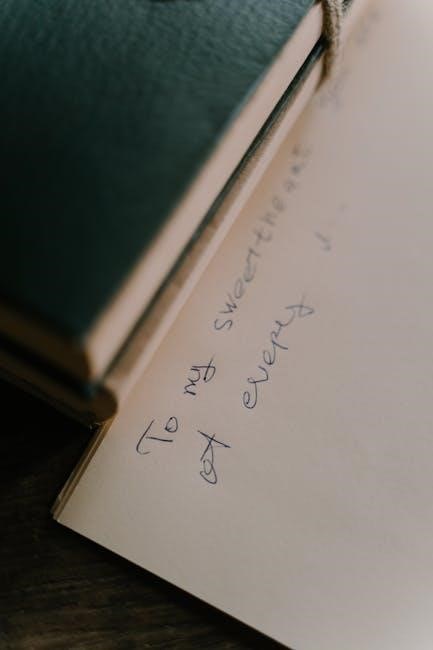Three-letter word worksheets are foundational tools for early literacy, helping children transition from alphabet recognition to forming simple words. They enhance phonemic awareness, spelling, and reading skills, making learning engaging and effective for young minds.

1.1 What Are 3 Letter Words Worksheets?
Three-letter word worksheets are educational tools designed to help young learners recognize, spell, and pronounce simple words. These worksheets typically feature activities like tracing, matching, and writing three-letter words, often accompanied by pictures or cues to aid understanding. They are structured with large, clear fonts and ample writing space, making them ideal for preschoolers or early learners. The focus is on foundational literacy skills, such as phonemic awareness and spelling patterns. These resources are widely available in PDF formats, offering convenience for teachers and parents to print and use in various learning environments. They are customizable to cater to different learning needs and styles, ensuring engaging and effective early literacy development.
1.2 Importance of Learning 3 Letter Words
Learning three-letter words is a crucial step in early literacy development, as it builds foundational language skills and confidence in young learners. These words introduce children to basic spelling patterns, phonemic awareness, and word structure, which are essential for reading and writing. Mastering three-letter words helps children recognize common word families and sound combinations, making future learning easier. It also enhances vocabulary and comprehension skills, preparing them for more complex texts. By focusing on simple, manageable words, children develop a strong base for lifelong literacy. This early exposure fosters a love for learning and sets the stage for academic success in later years.

Structure of 3 Letter Words Worksheets
Three-letter word worksheets typically include lists of words, tracing exercises, and matching activities. They are designed to help children recognize patterns, sounds, and word structures, building on alphabet knowledge to form simple words and sentences, fostering early literacy skills.
2.1 What Are 3 Letter Words?
Three-letter words are the simplest words in the English language, typically consisting of a consonant, a vowel, and another consonant. Examples include “cat,” “dog,” and “sun.” These words are foundational for early literacy, as they introduce children to word structure and phonetic patterns. They often represent common objects or actions, making them relatable and easy to remember. Three-letter words are essential for building phonemic awareness, spelling skills, and vocabulary. They also serve as a bridge from alphabet recognition to reading and writing more complex words. Understanding these words helps children decode and recognize patterns, making reading easier and more enjoyable. They are a crucial step in language development, fostering confidence and a strong literacy foundation.
2.2 The Significance of 3 Letter Words in Early Learning
Three-letter words play a vital role in early learning by introducing children to basic word structures and phonetic patterns. These simple words help bridge the gap between alphabet recognition and reading. They are often the first words children learn, representing familiar objects or actions, which makes them relatable and engaging. Learning three-letter words enhances phonemic awareness, decoding skills, and vocabulary. They also build confidence and lay the groundwork for more complex reading and writing. By focusing on common, high-frequency words, educators help children develop a strong foundation in literacy. This early exposure fosters a smooth transition to reading longer texts and understanding more intricate language concepts.
2.3 Designing Effective 3 Letter Words Worksheets
Creating effective three-letter word worksheets involves a structured approach to ensure they are both educational and engaging. Start by selecting high-frequency, age-appropriate words that align with curriculum goals. Use clear, large fonts for readability and incorporate visuals to aid recognition. Activities should vary, including tracing, matching, and fill-in-the-blank exercises, to cater to different learning styles. Organize the worksheet logically, progressing from simpler to more complex tasks. Incorporate colorful illustrations and themes to maintain children’s interest. Provide ample space for writing to accommodate developing fine motor skills. Including answer keys or feedback sections helps in assessing progress. Regularly updating content keeps the material fresh and relevant, ensuring continuous learning and engagement for young students.

Benefits of Using 3 Letter Words Worksheets
Three-letter word worksheets provide a foundational skill set for early literacy, enhancing phonemic awareness, spelling, and reading abilities. They make learning engaging and effective for young children.
3.1 Cognitive Development Through Word Recognition
Engaging with 3-letter word worksheets fosters cognitive development by enhancing word recognition skills. These exercises strengthen memory, attention, and problem-solving abilities, crucial for early learning. By repeatedly practicing word patterns, children develop phonological awareness, which is essential for decoding more complex texts later. The structured format of these worksheets helps build logical thinking and sequencing skills, laying a strong foundation for future academic success. As children progress, their ability to recognize and remember words improves, boosting their confidence and eagerness to learn. This incremental approach ensures a smooth transition from basic alphabet knowledge to advanced literacy skills.
3.2 Enhancing Language and Literacy Skills
Three-letter word worksheets play a vital role in enhancing language and literacy skills by introducing children to basic word structures. These exercises help children understand the relationship between sounds and letters, improving their phonics knowledge. By practicing spelling and reading simple words, kids develop a stronger foundation for language expression and comprehension. The repetitive nature of these worksheets reinforces vocabulary and sentence formation skills, making communication more fluid. Additionally, they encourage children to explore word meanings, fostering a deeper understanding of language. This structured approach ensures that young learners build confidence in their ability to read and write, setting them up for long-term literacy success.

3.3 Preparation for Academic Success
Three-letter word worksheets are essential for preparing young learners for academic success by building a strong foundation in literacy. These exercises introduce children to word patterns, spelling, and reading, which are critical skills for future learning. By mastering simple words, kids develop the confidence and ability to tackle more complex texts as they progress. The structured format of these worksheets also teaches children discipline and focus, skills that are transferable across all academic areas. Early exposure to word recognition and formation helps students stay ahead in their educational journey, ensuring they are well-prepared for the challenges of reading and writing in higher grades.
3.4 Development of Fine Motor Skills
Three-letter word worksheets play a significant role in enhancing fine motor skills in young children. Writing and tracing simple words require precise hand movements, which help improve dexterity and coordination. As children practice forming letters, they strengthen the muscles in their hands and fingers, essential for writing and drawing. The repetitive nature of these exercises reinforces muscle memory, making it easier for kids to write more complex words in the future. Additionally, using tools like pencils or crayons while completing worksheets helps refine their grip and control, contributing to overall motor skill development and preparing them for more advanced academic tasks.
Where to Find 3 Letter Words Worksheets
Educational websites, teacher resource platforms, and DIY templates are popular sources for 3-letter word worksheets, supporting early literacy and alphabet-based learning effectively.
4.1 Educational Websites Offering Free Worksheets
Several educational websites provide free 3-letter word worksheets in PDF format, designed to support early literacy skills. These resources are often created by educators and are tailored to meet the needs of preschool and kindergarten students. Popular platforms include Education.com, Teachers Pay Teachers, and Worksheetfun. They offer a variety of activities, such as tracing, matching, and fill-in-the-blank exercises, to engage young learners. Many worksheets are themed around common topics like animals, food, and household items, making learning fun and relatable. These resources are easily downloadable and printable, making them accessible for both classroom and home use. They cater to different learning styles and are a valuable tool for parents and teachers alike.
4.2 Teacher Resource Websites
Teacher resource websites are invaluable for educators seeking high-quality 3-letter word worksheets. Platforms like Teachers Pay Teachers and Education;com offer a wide range of downloadable PDF resources. These websites cater specifically to teachers, providing structured and curriculum-aligned materials. Many resources include interactive activities such as word tracing, matching games, and fill-in-the-blank exercises. They are designed to support phonics instruction and early literacy development. Teachers can also find themed worksheets to align with classroom topics, making learning engaging and relevant. These websites often feature reviews and ratings, helping educators choose the most effective materials. They serve as a time-saving solution for creating a structured and engaging learning environment for young students.
4.3 Creating Your Own DIY Worksheets
Creating DIY 3-letter word worksheets allows for customization to meet specific learning needs. Teachers and parents can design worksheets using tools like Microsoft Word or Google Docs. Incorporating visuals, such as images of objects, can enhance engagement. Themes like animals, food, or seasonal topics make learning fun. DIY worksheets enable the inclusion of words relevant to a child’s interests or curriculum. They also allow for varying difficulty levels, from tracing to writing independently. This personalized approach fosters a tailored learning experience, ensuring children stay motivated and engaged. DIY worksheets are cost-effective and adaptable, making them a valuable resource for early literacy development.
How to Use 3 Letter Words Worksheets Effectively
Using 3-letter word worksheets effectively involves creating a structured routine and incorporating multisensory techniques to enhance engagement and retention in early literacy skills development.
5.1 Creating a Learning Routine
Establishing a consistent learning routine is crucial for effective use of 3-letter word worksheets. Begin by designating specific times daily for practice, ensuring it becomes a habit. Start with short sessions to maintain focus and gradually increase duration as the child adapts. Incorporate visual aids and hands-on activities to make learning engaging. Use the worksheets to introduce new words, reinforcing recognition and spelling. Encourage repetition and provide immediate feedback to build confidence. Rotate activities to keep the routine fresh, such as tracing, matching, and reading aloud. Celebrate progress, no matter how small, to foster motivation and a positive attitude toward learning. Consistency and patience are key to maximizing the benefits of these worksheets.
5.2 Incorporating Multisensory Learning Techniques
Engaging multiple senses enhances learning, making 3-letter word worksheets more effective. Use visual aids like flashcards or colorful worksheets to capture attention. Auditory techniques, such as sounding out letters, help children connect sounds to symbols. Tactile activities, like tracing words or writing in sand, reinforce muscle memory. Combine these methods by having children write words while saying them aloud. Incorporate movement, such as jumping or clapping, to associate words with physical actions. Multisensory approaches cater to different learning styles, ensuring all children can thrive. This holistic method makes learning interactive and memorable, fostering a deeper understanding of 3-letter words and their structure. It also keeps young learners engaged and excited about their progress.

Assessing Progress with 3 Letter Words Worksheets
Regularly reviewing completed worksheets helps track a child’s mastery of 3-letter words. Look for correct word formation and recognition to gauge progress and identify areas needing more practice.

6.1 Tracking Improvement in Word Recognition
Tracking progress in word recognition using 3-letter word worksheets involves regularly reviewing completed exercises to identify improvements. Look for increased accuracy in reading and spelling simple words. Over time, observe if children can recognize words independently and apply them in sentences. Correctly formed letters and proper word associations are key indicators of progress. Use checklists or progress charts to document advancements, ensuring consistent improvement. Celebrate small milestones to motivate learners and encourage further development. This systematic approach helps tailor teaching methods to meet individual needs, fostering a strong foundation in early literacy skills. Regular assessment ensures targeted support, leading to steady growth in word recognition abilities.
6.2 Identifying and Addressing Learning Gaps
Identifying learning gaps in word recognition is crucial for effective instruction. Review completed worksheets to pinpoint words or patterns a child struggles with. Look for consistent errors in spelling or pronunciation. Once gaps are identified, tailor activities to focus on those specific areas. Use visual aids, repetition, and hands-on exercises to reinforce learning. For example, if a child confuses similar-sounding words, incorporate games or flashcards to clarify differences. Provide extra practice through targeted worksheets or interactive activities. Encourage a supportive environment where mistakes are seen as learning opportunities. Regularly reassess to ensure understanding and adjust strategies as needed. This approach helps bridge gaps and builds confidence in word recognition skills. Consistent effort leads to measurable improvement over time.

Advanced Activities for Older Children

For older children, advanced activities include building complex sentences with 3-letter words and exploring word families. These exercises enhance language skills and logical thinking abilities effectively.

7.1 Building Sentences with 3 Letter Words
Building sentences with 3-letter words is an excellent way to enhance language skills in older children. It encourages creativity and understanding of word order. Start with simple activities where children arrange 3-letter words to form short, meaningful sentences. For example, using words like “cat,” “run,” and “the,” they can create sentences like “The cat runs.” This activity improves grammar, vocabulary, and communication skills. Worksheets can include word banks and sentence frames to guide learners. Gradually introduce more complex words and longer sentences to challenge their abilities. This method fosters logical thinking and confidence in expressing ideas, making it a valuable step in advanced learning.
7.2 Exploring Word Families and Patterns
Exploring word families and patterns is a engaging way to deepen understanding of 3-letter words. Word families, such as -at, -an, or -in, share similar sounds and endings, helping children recognize patterns in language. Worksheets can include activities like matching games, fill-in-the-blank exercises, or identifying rhyming words. This approach enhances phonological awareness and spelling skills. For example, children can learn that changing the initial consonant in “cat” creates “bat” or “hat.” Such exercises foster creativity and critical thinking, while reinforcing vocabulary. Advanced worksheets might introduce more complex patterns, preparing children for higher-level reading and writing tasks. This method makes learning fun and intellectually stimulating, encouraging a deeper connection with language and its structure.
Three-letter word worksheets are invaluable for early literacy, fostering a strong foundation in reading and writing. They promote a lifelong love for learning and academic growth;
8.1 The Long-Term Impact of 3 Letter Words Worksheets
Three-letter word worksheets have a profound long-term impact on early learners, fostering strong reading and spelling skills that pave the way for future academic success. By mastering these foundational words, children build confidence and fluency, which are essential for advanced literacy. These worksheets also enhance cognitive development, improving memory and problem-solving abilities. Over time, they contribute to a smoother transition into more complex learning materials, ensuring a solid educational foundation. The skills gained from these exercises stay with learners throughout their lives, making them a cornerstone of early childhood education and a key to fostering a lifelong love for learning and growth.
8.2 Encouraging a Love for Learning
Three-letter word worksheets play a vital role in nurturing a love for learning in young children. By making education interactive and fun, these tools spark curiosity and creativity. Engaging with colorful, well-designed worksheets helps children associate learning with enjoyment, fostering a positive attitude toward academics. As they master simple words, their confidence grows, encouraging them to explore more complex concepts. These exercises also involve parents or caregivers, creating a supportive learning environment. Over time, this early exposure to structured yet playful education cultivates a lifelong appreciation for knowledge and intellectual growth, laying the groundwork for a child’s future academic and personal success.
